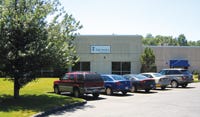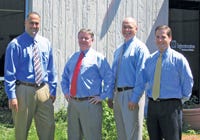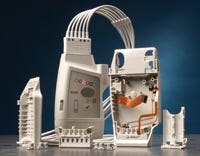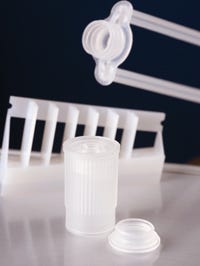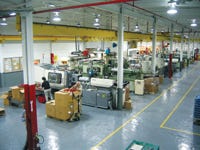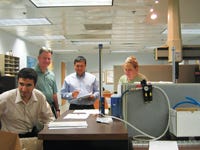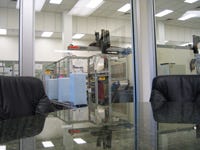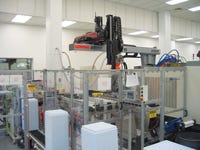As Ben Franklin once said, “When you’re finished changing, you’re finished.” With more than 65 years in the business, one molder learned long ago that it pays to change with the times and has, once again, changed for the better.
As Ben Franklin once said, “When you’re finished changing, you’re finished.” With more than 65 years in the business, one molder learned long ago that it pays to change with the times and has, once again, changed for the better.
|
"Our business has been very good since our separation from automotive. I’d say our sales have increased anywhere from 80-100%,” says Paul Nazzaro, president and CEO of Injectronics Corp. (Clinton, MA), welcoming us for our second Injectronics tour. Our first was more than a decade ago (see imm.plasticstoday.com/?q=articles/8406).
As previously reported, the custom molding operation that became Injectronics was launched in Clinton in 1942 by F.J. Kirk, a founding father of the U.S. custom molding business. Kirk launched another company to specialize in molding nylon a few years later, Nypro Inc., right next door. Nypro’s progenitor was reincorporated as Injectronics Inc. in the late 1960s.
Since our last visit, Injectronics has consolidated its operations around the country, while expanding its manufacturing base in its home state. It’s also performed plastics surgery on itself. Once predominantly automotive, Injectronics’ business is now 90% medical. It’s combined the management and manufacturing practices mastered while serving automotive with its existing medical molding expertise, and it’s added new strategic initiatives and manufacturing technologies to better serve its growing list of new customers. Let’s see. Let’s tour.
Proactive partnering
Ushering us into the conference room, Nazzaro and his colleague, John Schwab Jr., Injectronics’ director of sales and marketing, introduce us to two of their colleagues—Michael Bowe, executive VP and CFO, and Mark Licari, VP of engineering.
“There was a considerable opportunity for profit and growth in automotive and we had a vibrant business,” Nazzaro says. “We learned there is a huge benefit to our customers today, especially in terms of quality assurance and design support.”
“Actually,” says Schwab, “we’ve been involved in medical since the 1970s. Now we’re into it full force.”
“Part of our success, tied to our commitment to year-after-year cost-savings initiatives, is based on our customers’ success—it’s a win-win for both sides,” says Licari.
“We put considerable effort into working with our customers to assess their real needs,” Bowe adds.
As we’re about to tour, Schwab says, “We’ve always had a philosophy that’s been engineering based and we’ve stayed true to our path. Fiscally—operationally—we’re conservative. We’re not doing anything just because everyone else is doing it. We’re more into positioning ourselves to sell solutions, which include contract manufacturing. Value-add drives things around here. Our suggestions and improvements may change our customers’ systems. That’s why two-way conversation and early involvement are vital.
“We have an open-door policy,” he adds. “In fact, we do open-book costing with several customers. They see exactly what’s going on here. Our total variance on profit and loss is less than 1%, thanks largely to our experience in process development and tooling. And we’re finding ways to become even better, faster, and cheaper.”
One-stop shop
Injectronics Clinton is a two-story building. Its administrative offices are all up front, and its engineering offices are upstairs, where designers use SolidWorks engineering software. Its ISO Class 8 cleanroom is about 6000 ft2, and represents about a $1 million investment in equipment and buildout.
We’re escorted to a cell that’s unlike any we’ve ever seen. There’s a Motoman six-axis robot in it—we’re sure of that. Noticing our puzzled look, Schwab tells us the primary machine the robot’s serving is a thermoforming machine.
Schwab explains that the addition of thermoforming to its capabilities started as a cost-savings initiative for a major customer. “We said, why not let us do the kitting and final packaging, too?”
The thermoforming equipment is from Sencorp Inc. (Hyannis, MA). Parts assembly and packaging also is performed in Injectronics’ Clinton cleanroom. The thermoforming machine’s tooling uses technologies Injectronics borrowed from its injection mold engineering resources. As a result, it requires less labor content and produces nearly zero scrap, improving utilization.
Injecting invulnerability
Injectronics has about 200-250 active injection molds. Its hot runner systems are from Husky and Mold-Masters. Though it outsources mold builds, the toolroom is staffed by seasoned experts. All cleaning and repair details are managed through Injectronics’ IQMS ERP system. It’s been using IQMS for about seven years.
Since 1991, the company has used an evolving set of its own rigorous mold standards to optimize mold performance. It also uses cycle counters to ensure proper mold maintenance scheduling, mold longevity, and part quality.
In the main molding room, it’s evident that Injectronics remains devoted to Nissei molding machines. There are 18 of them here lined perpendicular to the wall under 1- and 2-ton cranes with about 15-ft hook heights and bright metal halite lighting. The shop floor is epoxy coated.
“Every mold gets a job book,” Schwab explains, as we pass a shelf filled with them. “We overdocument, overcheck, and then repeat the process, including records of sampling defects. We’ve also developed our own system, MoldPac. It’s a scientific approach to determining molding windows—a simplified DOE for every process and part. Still, every project engineer is responsible for making his or her project successful.”
We pause at one cell to admire the big containers it’s making. Nazzaro says they’re Iron Mountain tray containers manufactured for XpresspaX Inc. (Westborough). “It’s superstrong,” Schwab says. “You can hit one with a hammer and it won’t break.” One complete assembly is produced on every cycle.
Cellular cleanroom
After our arrival at Injectronics Westborough, we’re told the facility was leased in 2002. Through a window in the conference room we have a great view of the shop’s ISO Class 8 production area. The plant is 20,000 ft2, but there’s about 12,000 ft2 of additional space that could be available for expansion. Schwab says the shop sometimes runs 24/7—one cell runs 280 days/year. There’s a small toolroom, mostly for PM.
Seventeen employees work here—four per shift. All of the cells were Injectronics-engineered and DOEs are performed on all the processes. Westborough is interfaced online to the IQMS system running in Clinton.
The production area has an 18-ft-high ceiling, epoxy flooring, fluorescent lighting, and there’s 5S signage everywhere.
The first of the five molding machines we see originally ran a 16-cavity mold. It’s now running clear PS parts in 32-cavity Ivanhoe tooling with interchangeable cores in a fully automated cell with a machine-mounted Wittmann robot. Parts are removed, degated, and oriented on a TEC belt conveyor. Automated vision inspection spots for any embedded contamination, black specks, and splay. A fixed automation system packages the parts into thermoformed trays that are automatically stacked.
Another cell at the far end of the floor immediately grabs our attention. First, we notice it’s not a Nissei molding machine. Second, the machine is unrecognizable.
Smiling at our confusion, Nazzaro says, “It’s a Sacmi.”
High-speed contract manufacturing
In 32-cavity molds, two Sumitomo SE280HS machines are molding caps. The caps are for PAP-test vials molded here in 16-cavity tooling on a Nissei NEX 6000. These caps have to be lined. That’s where the Sacmi comes in, and that’s why Sumitomos were chosen—for their speed and availability.
The Sacmi is a high-speed rotational compression molding machine from Sacmi USA (Des Moines, IA). Injectronics worked with a lab to develop a special TPE liner material from DSM that prevents leakage of a methanol-based preservative solution.
A Sterling weigh-based feeder ensures caps molded on the Sumitomo are right side up when loaded into the Sacmi through purpose-built automation. After the Sacmi extrudes and compression molds the liners into the caps, the caps are automatically transferred down a track to where they’re automatically inspected.
Two automated vision inspection systems and a 100% leak tester are in the cell. The Sacmi produces 500 finished caps/min. It takes two high-speed Sumitomos to keep up with the compression press’s output. “We only need to run it 8 hours a day,” says Licari. “We’ve produced 44 million caps in just 10 months.”
So, what’s ahead? Nazzaro says that although the company’s goal is 20%/year growth, 10-15% growth may be a more reasonable estimate. “And we’re looking out for strategic acquisition opportunities,” he adds. “We’re also expanding our sourcing activities in low-cost countries. Our business for 2008 is looking good as the year winds down. In fact, it’s looking fantastic."
Vital Stats: Injectronics Corp., Clinton and Westborough, MA
Facility size: Clinton—78,000 ft2; Westborough—20,000 ft2
Annual sales: $18 million
Markets served: Medical devices and disposables (90%), IT media storage, consumer products (10%)
Capital investment: $5 million (combined between facilities)
Parts produced: Clinton—more than 20 million/year; Westborough—more than 150 million/year
Materials processed: PS, PP, PC/ABS and other PC blends, TPE, PC, HDPE, modified-PPO, PC, HDPE
Resin consumption: More than 4 million lb/year (combined)
No. of employees: 75
Shifts: Three shifts, five days/week
Molding machines: Clinton—18, 83-620 tons, Nissei; Westborough—five, 150-300 tons, Nissei and Sumitomo
Secondary operations: Automated vision inspection, pad printing, ultrasonic welding, heatstaking, automated packaging, membrane bonding, foil sealing, testing—including pressure resistance, water resistance, and electrical
Internal moldmaking: No
Quality: ISO 13485, ISO 9001:2000, Six Sigma
?www.injectronics.com
About the Author(s)
You May Also Like

